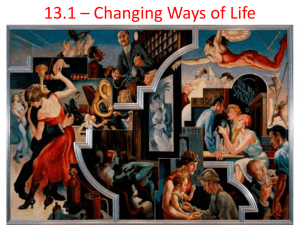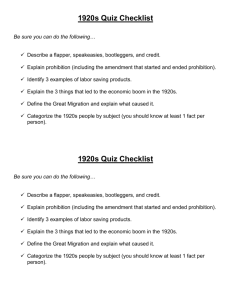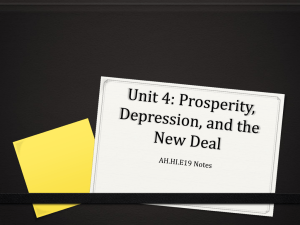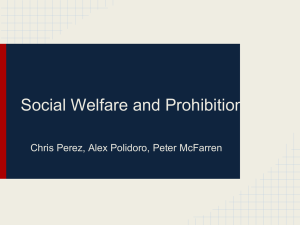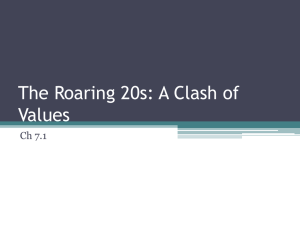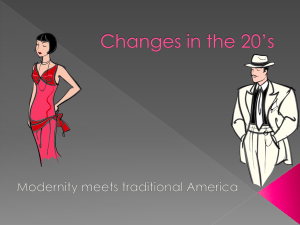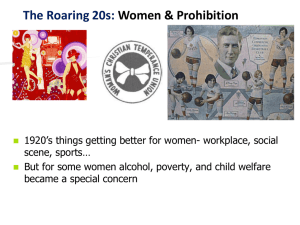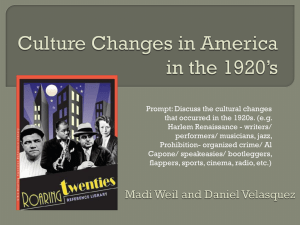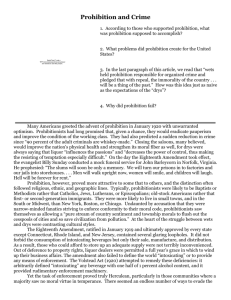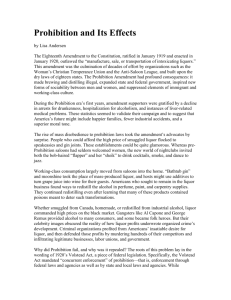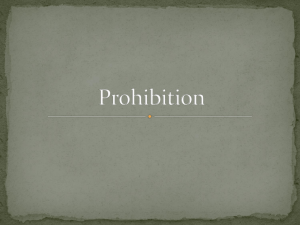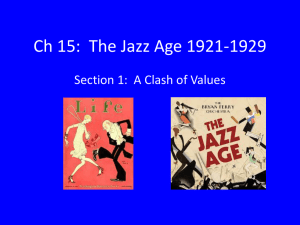Prohibition
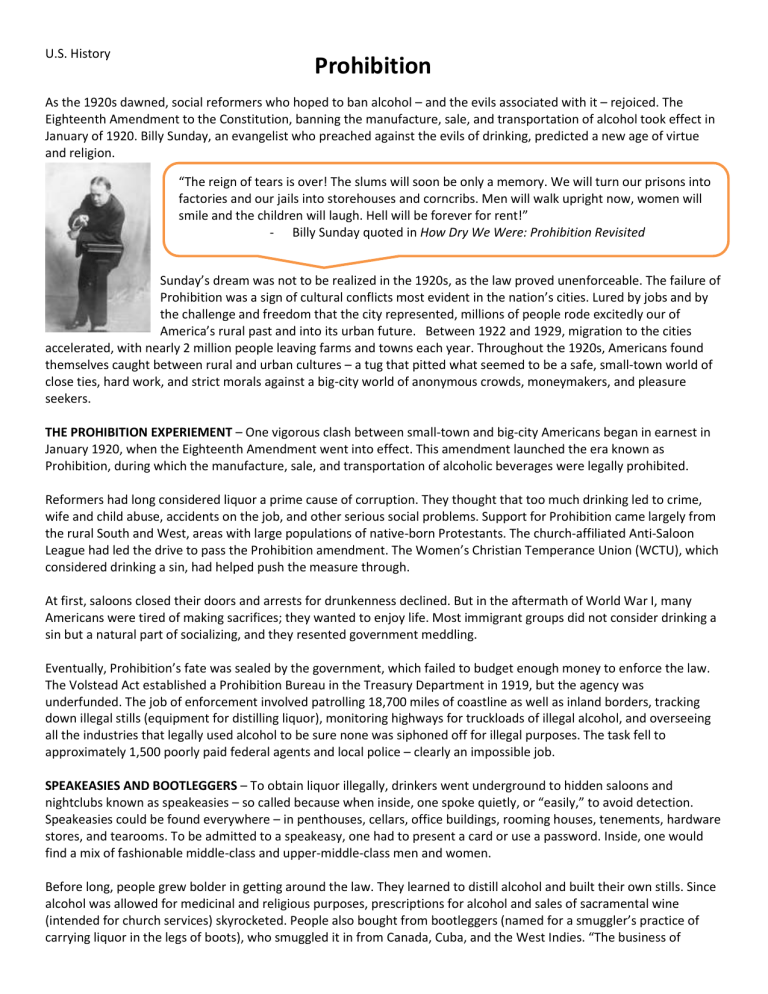
U.S. History
Prohibition
As the 1920s dawned, social reformers who hoped to ban alcohol – and the evils associated with it – rejoiced. The
Eighteenth Amendment to the Constitution, banning the manufacture, sale, and transportation of alcohol took effect in
January of 1920. Billy Sunday, an evangelist who preached against the evils of drinking, predicted a new age of virtue and religion.
“The reign of tears is over! The slums will soon be only a memory. We will turn our prisons into factories and our jails into storehouses and corncribs. Men will walk upright now, women will smile and the children will laugh. Hell will be forever for rent!”
Billy Sunday quoted in How Dry We Were: Prohibition Revisited
Sunday’s dream was not to be realized in the 1920s, as the law proved unenforceable. The failure of
Prohibition was a sign of cultural conflicts most evident in the nation’s cities. Lured by jobs and by the challenge and freedom that the city represented, millions of people rode excitedly our of
America’s rural past and into its urban future. Between 1922 and 1929, migration to the cities accelerated, with nearly 2 million people leaving farms and towns each year. Throughout the 1920s, Americans found themselves caught between rural and urban cultures – a tug that pitted what seemed to be a safe, small-town world of close ties, hard work, and strict morals against a big-city world of anonymous crowds, moneymakers, and pleasure seekers.
THE PROHIBITION EXPERIEMENT – One vigorous clash between small-town and big-city Americans began in earnest in
January 1920, when the Eighteenth Amendment went into effect. This amendment launched the era known as
Prohibition, during which the manufacture, sale, and transportation of alcoholic beverages were legally prohibited.
Reformers had long considered liquor a prime cause of corruption. They thought that too much drinking led to crime, wife and child abuse, accidents on the job, and other serious social problems. Support for Prohibition came largely from the rural South and West, areas with large populations of native-born Protestants. The church-affiliated Anti-Saloon
League had led the drive to pass the Prohibition amendment. The Women’s Christian Temperance Union (WCTU), which considered drinking a sin, had helped push the measure through.
At first, saloons closed their doors and arrests for drunkenness declined. But in the aftermath of World War I, many
Americans were tired of making sacrifices; they wanted to enjoy life. Most immigrant groups did not consider drinking a sin but a natural part of socializing, and they resented government meddling.
Eventually, Prohibition’s fate was sealed by the government, which failed to budget enough money to enforce the law.
The Volstead Act established a Prohibition Bureau in the Treasury Department in 1919, but the agency was underfunded. The job of enforcement involved patrolling 18,700 miles of coastline as well as inland borders, tracking down illegal stills (equipment for distilling liquor), monitoring highways for truckloads of illegal alcohol, and overseeing all the industries that legally used alcohol to be sure none was siphoned off for illegal purposes. The task fell to approximately 1,500 poorly paid federal agents and local police – clearly an impossible job.
SPEAKEASIES AND BOOTLEGGERS – To obtain liquor illegally, drinkers went underground to hidden saloons and nightclubs known as speakeasies – so called because when inside, one spoke quietly, or “easily,” to avoid detection.
Speakeasies could be found everywhere – in penthouses, cellars, office buildings, rooming houses, tenements, hardware stores, and tearooms. To be admitted to a speakeasy, one had to present a card or use a password. Inside, one would find a mix of fashionable middle-class and upper-middle-class men and women.
Before long, people grew bolder in getting around the law. They learned to distill alcohol and built their own stills. Since alcohol was allowed for medicinal and religious purposes, prescriptions for alcohol and sales of sacramental wine
(intended for church services) skyrocketed. People also bought from bootleggers (named for a smuggler’s practice of carrying liquor in the legs of boots), who smuggled it in from Canada, Cuba, and the West Indies. “The business of
evading [the law] and making a mock of it has ceased to wear any aspects of crime and has become a sort of national sport” wrote the journalist H.L. Mencken.
ORGANIZED CRIME – Prohibition not only generated disrespect for the law, it also contributed to organized crime in nearly every major city. Chicago became notorious as the home of Al Capone, a gangster whose bootlegging empire netted over $60 million a year. Capone took control of the
Chicago liquor business by killing off his competition. During the 1920s, headlines reported 522 bloody gang killings and made the image of flashy Al Capone part of the folklore of the period.
By the mid-1920s, only 19% of Americans supported Prohibition. The rest, who wanted the amendment changed or repealed, believed that Prohibition caused worse effects than the initial problem. Rural Protestant Americans, however, defended a law that they felt strengthened moral values. The Eighteenth Amendment remained in force until 1933, when it was repealed by the
Twenty-first Amendment.
PROHIBITION, 1920 – 1933
Various religious groups thought drinking alcohol was sinful
Causes
Reformers believed that the government should protect the public’s health
Reformers believed that alcohol led to crime, wife and child abuse, and accidents on the job
During WWI, native-born Americans developed a hostility to German-American brewers & toward other immigrant groups that used alcohol
Effects
Consumption of alcohol declined
Disrespect for the law developed
An increase in lawlessness, such as smuggling & bootlegging, was evident
Criminals found a new source of income
Organized crime grew
To Prohibit Alcohol or Not?
The question of whether to outlaw alcohol divided Americans. Many believed the government should make alcohol illegal to protect the public, while others believed it was a personal decision, and not morally wrong.
Questions to consider:
1.
What is the big idea of the 18 th Amendment?
2.
Discuss the trends that influenced the era of Prohibition.
3.
Create a T-chart to identify the ethics of Prohibition. Specifically identify Pros (benefits/justifications) and Cons
(problems) of Prohibition. List several for each.
4.
If you had been a legislator asked to vote for the 18 th Amendment, what would you have said? Consider your
point of view (i.e. where are you from, what is your religious background, what is your gender, etc.)
5.
What happens when the government legislates moral values? Consider change over time and relate government involvement with Prohibition to a current issue. Support your answer.
